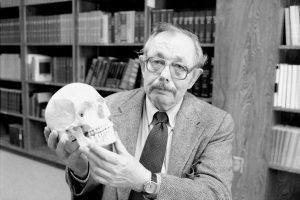Forensic Anthropology
| They could be, at first glance, only bones, rickety bones buried by the roadside. Abandoned bones, not caressed bones a pain not shrouded. |
Podrían ser, a simple vista, sólo huesos, desvencijados huesos enterrados al borde del camino. Abandonados huesos, no acariciados huesos de un dolor no amortajado. |
|
|
|
| But they are not, at first glance, only bones, rickety bones. In the calcium of the bone there is a story: desperate story, sprawling story of premeditated terror. |
Pero no son, a simple vista, sólo huesos, desvencijados huesos. En el calcio del hueso hay una historia: desesperada historia, desmadejada historia de terror premeditado. |
|
|
|
| And we must tell, unearth, match, take the bone into the clean air of life. Pending hug, farewell, kiss, flower, in the right place of the scar. |
Y habrá que contar, desenterrar, emparejar, sacar el hueso al aire puro de vivir. Pendiente abrazo, despedida, beso, flor, en el lugar preciso de la cicatriz. |
What is Forensic Anthropology?
Forensic anthropology: The sub-field of physical anthropology that seeks to identify human remains. Forensic anthropologists study skeletal remains to determine the sex, age, height, occupation, etc. It was officially recognized as a discipline in 1972 by the American Academy of Forensic Sciences.
Humanitarian Forensic Action: The application of forensic sciences to humanitarian settings, including conflict and disaster zones.
The information gathered through forensic anthropology is sometimes used in criminal proceedings to find justice if the individual was murdered. One such example is the trial of Rios Montt, the infamous Guatemalan dictator in the 1980's, who, in 2013, was convicted of ordering genocide of Mayan people. A team of forensic anthropologists were able to analyze the skeletal evidence and determine how the deceased died, and also that the bones they analyzed came almost exclusively from the indigenous Mayan people. They were able to prove that the method of killing was consistent with genocide and was executed by Guatemalan government forces. However, criminal justice extends beyond the court; forensic anthropology is crucial to proving how a person died and bringing closure to families of the missing. The identification of the bodies of the desaparecidos can bring peace to their loved ones. It allows the chance for closure and a proper burial.
Unlike DNA evidence, forensic anthropology can answer questions surrounding the physical circumstances of a person’s death.
"Forensic anthropology is meaningful to help people solve these crimes. Trials are often based on lack of information- so if the information never comes out, the crime is still happening. People who have lost their family members suffer from psychological torture that doesn't end. Solving these cases stop crimes that continue to progress." - Emily Willard
According to Emily Willard, a Ph.D student completing her dissertation on transitional justice systems in Guatemala, forensic anthropology allows prosecutors to take DNA evidence and corroborate it with eyewitness testimony, documents, and photographs. Forensic anthropology promotes the finding of “all the parts to this puzzle”, rather than just one part.
Forensic Anthropology in Action: Dr. Clyde Snow
Dr. Clyde Snow was a well-known forensic anthropologist. In addition to identifying death-squad victims in Argentina, Dr. Snow also identified the body of Joseph Mengele, a Nazi physician responsible for cruel experiments on Auschwitz prisoners, and confirmed President John F. Kennedy’s assassination. Dr. Snow passed away in 2014, but the impact of his work in Latin America is still remembered today. He pioneered the application of forensic anthropology in human rights settings in Guatemala and was instrumental to the conviction of Rios Montt. He trained local teams of students to exhume and analyze victims of the "Dirty Wars" in Argentina, Guatemala, and Chile. Snow even inspired Freddy Peccerelli, who started the FAFG, the Forensic Anthropology Foundation of Guatemala, and inspired the creation of other forensic anthropology teams across the region. His passion for human rights and justice drove him to this work and ultimately showed through his commitment to bringing closure to families of the disappeared.
"People will never respect the law until there’s justice. And a good place to start is with murder . . . It’s very difficult to argue with a skull with a bullet in its head." - Clyde Snow
ACHIEVEMENTS
- Identified the remains of death-squad victims in Argentina, including remains of indigenous Mayan people.
- Was a witness to trials of several high-ranking military officials who were accused of the killings.
- Studied the remains of 136 children in El Salvador who had been killed by machine guns.
Necroviolence, Necropolitics, and Human Rights in Guatemala
Necropolitics
The relationship between sovereignity, life and death; the ability to decide who lives and who dies; the power to define life
Necroviolence
Violence produced through the treatment of corpses; the use of the dead to control and torture the living
